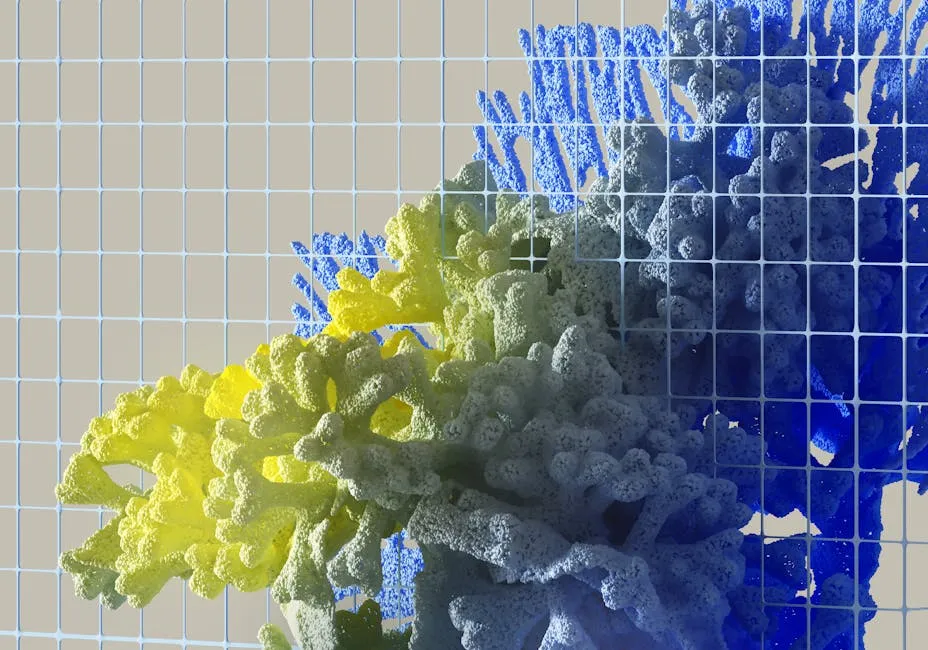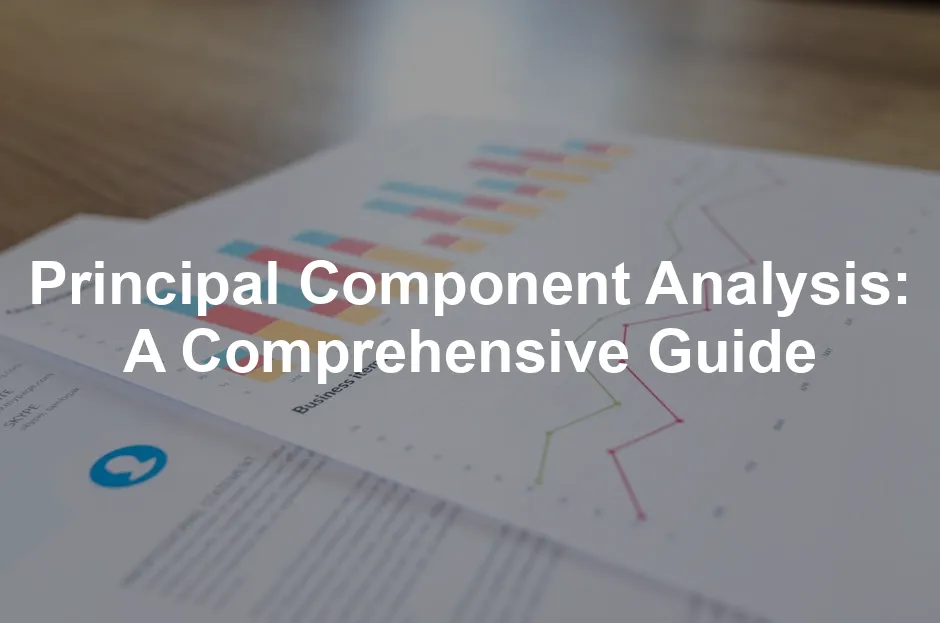Introduction
Principal Component Analysis (PCA) is a key statistical method for dimensionality reduction. It simplifies complex datasets while retaining essential information. PCA is vital for data analysis, visualization, and machine learning. This article aims to clarify PCA, highlighting its applications and implementation. If you’re looking to dive deeper into the world of data science, consider picking up the Python Data Science Handbook: Essential Tools for Working with Data to get started!
Summary and Overview
PCA transforms a dataset by reducing its dimensionality while keeping the most variance. The primary goal is to simplify data without losing critical information. It achieves this by converting correlated variables into uncorrelated principal components. These components represent the directions of maximum variance in the data. PCA finds its applications in various fields, including genetics, image processing, and finance. In genetics, it helps analyze gene expression data. In finance, it aids in portfolio management by identifying key risk factors. Furthermore, PCA plays a crucial role in overcoming the “curse of dimensionality,” enhancing data analysis and machine learning model performance. By reducing dimensions, it minimizes noise and improves interpretability. For more insights on the importance of data analysis in these contexts, check out these tips for effective data analysis in economics and statistics. You might also want to explore The Elements of Statistical Learning: Data Mining, Inference, and Prediction for a more in-depth understanding of statistical methods.Understanding the significance of data analysis can enhance your grasp of PCA’s applications. tips for effective data analysis in economics and statistics

Understanding Principal Component Analysis
What is PCA?
Principal Component Analysis (PCA) is a statistical method aimed at reducing the dimensionality of large datasets. Developed by Karl Pearson in 1901, PCA seeks to summarize complex data while preserving the most significant patterns. This technique has gained traction with the rise of computational power, allowing for extensive data analysis. If you want to get started with PCA in Python, consider checking out Deep Learning with Python for practical insights. Variance plays a crucial role in PCA. The method identifies principal components, which are new variables that capture the most variance from the original dataset. By focusing on these components, PCA helps in filtering out noise and highlighting the structure of the data.
Key Concepts in PCA
At the heart of PCA are principal components, eigenvalues, and eigenvectors. Principal components are orthogonal vectors derived from the original variables, representing directions of maximum variance. Each component corresponds to an eigenvalue, indicating the amount of variance captured by that component. For a solid understanding of these concepts, you can refer to Practical Statistics for Data Scientists: 50 Essential Concepts. The covariance matrix is another essential concept in PCA. It quantifies how much the variables in the dataset vary together. By computing this matrix, PCA identifies relationships among variables, enabling the extraction of principal components. Thus, the covariance matrix serves as the foundation for understanding the variance structure within the data.
Applications of PCA
Data Visualization
PCA simplifies complex datasets. By reducing dimensions, it makes visualization more manageable. Imagine trying to see a 3D object from different angles. PCA helps by projecting this object onto a 2D plane. This projection highlights the main features, allowing for clearer interpretation. Users can identify patterns or clusters that may have been hidden in high-dimensional data. In essence, PCA transforms intricate datasets into visual formats that are easier to comprehend and analyze. If you’re interested in learning more about data visualization, check out Data Visualization: A Practical Introduction.
Image Processing
In image processing, PCA is a game changer. It aids in both image compression and recognition. By reducing the number of pixels needed to represent an image, PCA keeps essential visual information while discarding redundancies. This reduction saves storage space. Additionally, PCA helps in facial recognition systems. By extracting key features, it improves accuracy and speeds up processing. The technique identifies vital aspects of images, making it an invaluable tool in computer vision. For practical applications in image processing, consider Computer Vision: Algorithms and Applications.
Genomics and Bioinformatics
Genomics benefits immensely from PCA. It helps analyze gene expression data efficiently. In studies involving thousands of genes, PCA reduces complexity. By focusing on key principal components, researchers can identify significant patterns in gene activity. This insight can lead to discoveries in disease mechanisms and treatment responses. PCA enables the visualization of high-dimensional genomic data, making it easier to interpret complex biological relationships. For more information on data science in genomics, check out Data Science for Business: What You Need to Know about Data Mining and Data-Analytic Thinking.
Marketing and Customer Segmentation
Businesses leverage PCA for marketing and customer segmentation. By analyzing customer data, it uncovers distinct segments within a market. For instance, PCA can reveal customer preferences based on purchasing behavior. This information allows companies to tailor their marketing strategies effectively. Understanding these segments helps in personalizing recommendations, leading to improved customer satisfaction. Ultimately, PCA facilitates data-driven decisions that enhance marketing efforts. To enhance your marketing strategies, consider reading Data-Driven Marketing: The 15 Metrics Everyone in Marketing Should Know.
Advantages and Limitations of PCA
Advantages
PCA offers several benefits. First, it reduces dimensionality, simplifying data analysis. This reduction leads to lower computational costs and faster processing times. Second, it enhances model performance by minimizing noise and focusing on significant features. Third, PCA helps in visualizing data, making patterns more apparent. Lastly, by extracting principal components, it aids in removing redundant information, allowing for clearer insights. If you’re eager to learn more about these concepts, check out The Art of Data Science.
Limitations
Despite its advantages, PCA has challenges. One major limitation is interpretation difficulty. Principal components can be abstract, making it hard to relate them back to original variables. Additionally, PCA assumes linear relationships, which may not always hold true. This limitation can lead to oversimplifications. Another concern is potential information loss during dimensionality reduction. Finally, PCA is sensitive to scaling, necessitating careful preprocessing of data before application. If you’re interested in understanding these limitations further, consider reading Data Science for Dummies.
Alternative Methods to PCA
Kernel PCA
Kernel PCA extends traditional PCA by incorporating kernel methods. This approach is effective for capturing non-linear relationships among data points. By mapping data into a higher-dimensional space, Kernel PCA allows for the identification of complex patterns that linear PCA might miss. The use of kernels, such as polynomial or radial basis functions, transforms the data, enabling the analysis of intricate structures. This makes Kernel PCA a powerful tool when dealing with datasets that exhibit non-linear characteristics. For more on advanced techniques, consider Understanding Machine Learning: From Theory to Algorithms.Factor Analysis
While PCA focuses on reducing dimensionality by maximizing variance, factor analysis aims to uncover underlying relationships among variables. It identifies latent variables that explain observed correlations. Factor analysis is often employed in social sciences and psychology to explore constructs like intelligence or personality traits. In contrast, PCA is more commonly used for preprocessing data in machine learning. The choice between them depends on the research question. If the goal is to simplify data while preserving variance, PCA is ideal. For understanding relationships among variables, factor analysis is preferred. For a more comprehensive view, you might want to check out The Data Science Handbook: A Comprehensive Guide to Data Science.
t-SNE and UMAP
t-SNE (t-distributed Stochastic Neighbor Embedding) and UMAP (Uniform Manifold Approximation and Projection) are powerful alternatives for dimensionality reduction and visualization. t-SNE excels in preserving local structures, making it ideal for visualizing clusters in high-dimensional data. UMAP, on the other hand, offers faster computation and maintains both local and global structures. These techniques are particularly useful in fields like genomics and image processing, where complex, high-dimensional datasets need effective visualization. Both methods provide intuitive visual representations that help reveal hidden patterns in the data. For more insights into these methods, consider Data Mining: Concepts and Techniques.Conclusion
In summary, PCA is a fundamental technique for reducing dimensionality and simplifying complex datasets. It plays a crucial role in various fields, including finance, genetics, and marketing. By transforming correlated variables into uncorrelated principal components, PCA enhances data analysis and visualization. Its ability to minimize noise and improve interpretability makes it an essential tool for data scientists. For a deeper dive into the statistical methods relevant to finance, you can explore statistical methods for finance professionals 2024. If you’re working with high-dimensional data, consider implementing PCA to uncover valuable insights and optimize your analyses. For additional resources, you might want to check out The Data Science Toolkit: A Comprehensive Guide.
Understanding statistical methods can enhance your application of PCA in finance. statistical methods for finance professionals 2024
FAQs
What is the main purpose of PCA?
The main purpose of Principal Component Analysis (PCA) is to reduce the dimensionality of a dataset while retaining as much variance as possible. By transforming a high-dimensional dataset into a lower-dimensional one, PCA simplifies data analysis and visualization. This process helps highlight the most significant patterns, making it easier to interpret complex datasets. Imagine trying to find meaningful insights in a sea of numbers; PCA acts like a spotlight, illuminating the key features that matter most.
Is PCA supervised or unsupervised?
PCA is an unsupervised learning technique. This means it does not rely on labeled data or specific outcomes during the analysis. Instead, PCA focuses solely on the inherent structure of the data, identifying patterns and relationships among the variables. By doing so, it helps reveal the underlying structure without preconceived notions or biases, allowing for a more objective analysis.
What are principal components?
Principal components are new variables created through PCA. They are linear combinations of the original variables and represent directions in which the data varies the most. The first principal component captures the maximum variance, while subsequent components capture decreasing amounts of variance. This transformation enables data to be represented in a way that highlights the most important features, simplifying analysis and visualization.
When should PCA be applied?
PCA is particularly useful in scenarios where datasets have high dimensionality or multicollinearity. If you’re dealing with large datasets with many features, applying PCA can help reduce complexity and enhance interpretability. It’s also beneficial when you want to visualize relationships in the data or when preparing your data for machine learning algorithms. For instance, in image processing or genomics, PCA can reveal hidden patterns that might otherwise be lost.
What are the limitations of PCA?
While PCA is a powerful tool, it has some limitations. One major challenge is interpretation; principal components can be abstract and may not have clear meanings related to the original variables. Additionally, PCA assumes linear relationships, which may not hold true in all datasets. There’s also the risk of losing important information during dimensionality reduction. Lastly, PCA is sensitive to scaling; hence, proper data standardization is essential for accurate results.
All images from Pexels




